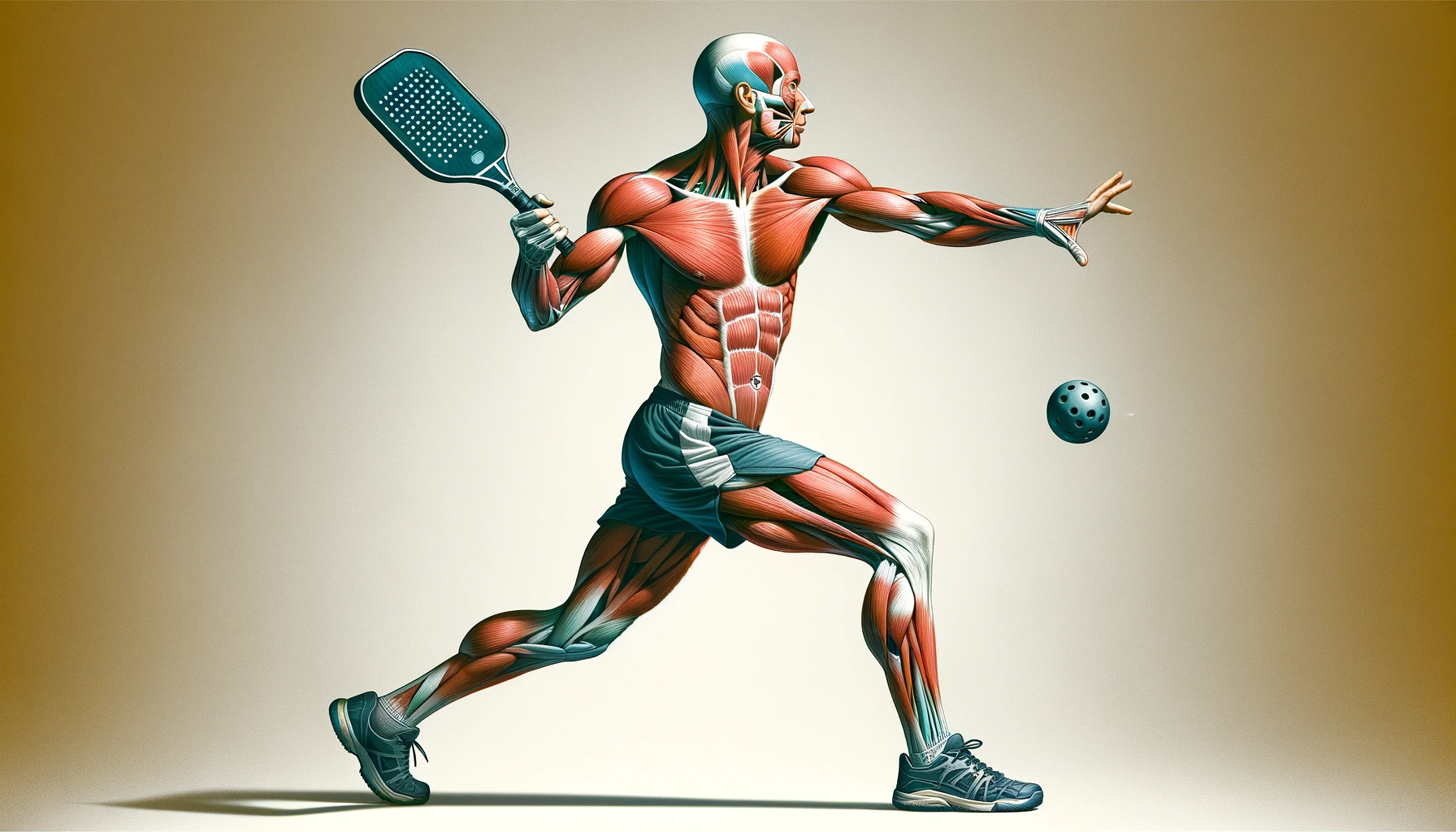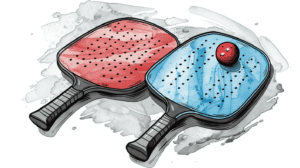What Muscles Does Pickleball Work
Last updated

So, you’re either already enjoying the fast-paced world of pickleball, or you’re gearing up to start playing. As you prepare to step onto the court, a key question might pop into your mind. What muscles does pickleball work?
Whether you’re dashing across the court for a swift return, lunging for a tricky shot, or powering through a serve, pickleball is a fantastic way to work out various muscle groups while having a blast.
Let’s dive into the specifics of this dynamic sport and discover the muscular benefits it offers.
What Muscles Does Pickleball Work in Short
Pickleball is a full-body workout that engages a diverse range of muscles. You’re primarily working your lower body – think quads, hamstrings, and calves – as you dart across the court. Your core muscles, including the abdominals and obliques, are constantly at play, maintaining your balance and stability. Upper body muscles, especially the shoulders, chest, and arms, get their fair share of the action, too, powering those swift, strategic shots.
What Muscles Do You Use When You Play Pickleball?
When you play pickleball, you engage a dynamic array of muscles, notably your deltoids, triceps, biceps, core, glutes, quads, and calves.
The sport demands upper body strength for effective strokes, a strong core for stability and precision, and robust lower body muscles for swift, agile movements on the court.
The sport demands upper body strength for effective strokes, a strong core for stability and precision, and robust lower body muscles for swift, agile movements on the court.
What Are the Benefits of Working These Muscles?
Working these muscles through pickleball brings a cascade of benefits, enhancing muscular endurance, agility, and coordination.
It’s a fun-filled path to a toned, more resilient body, improving your daily life with better posture and reduced risk of injury.
However, it’s important to consider all aspects of your health while enjoying the sport.
Suppose you’re curious about the impact of pickleball on your back. In that case, you might find it useful to explore the topic further in this article, Is pickleball bad for your back?
This approach ensures you enjoy the sport while being mindful of your overall well-being.”
It’s a fun-filled path to a toned, more resilient body, improving your daily life with better posture and reduced risk of injury.
However, it’s important to consider all aspects of your health while enjoying the sport.
Suppose you’re curious about the impact of pickleball on your back. In that case, you might find it useful to explore the topic further in this article, Is pickleball bad for your back?
This approach ensures you enjoy the sport while being mindful of your overall well-being.”
How To Train These Muscles?
To effectively train for pickleball, focus on exercises that target the key muscle groups used in the game.
For lower body strength, essential for quick movements and stability, incorporate exercises like lunges, squats, and calf raises.
Understanding the importance of targeted exercises for pickleball can be especially relevant for those wondering if they can play pickleball after knee replacement, as it emphasizes the need for lower body strength and stability, crucial for a safe return to the game.
For upper body strength, crucial for powerful serves and returns, include push-ups, shoulder presses, and rows in your workout. These exercises strengthen your deltoids, triceps, and biceps, directly impacting your stroke power and control.
Core strength is vital for overall stability and agility on the court. Engage in planks and Russian twists, which not only build a strong core but also improve your rotational movement, essential for those quick, reactive shots in pickleball.
Remember, consistency in your training regimen is key. Regularly practising these exercises. Ideally, 3-4 times a week will not only enhance your performance on the court but also contribute to your overall physical fitness.
As you progress, gradually increase the intensity and volume of your workouts to continue challenging your muscles and improving your game.
This approach ensures holistic development, making you a stronger, more agile, and more resilient pickleball player.
For lower body strength, essential for quick movements and stability, incorporate exercises like lunges, squats, and calf raises.
Understanding the importance of targeted exercises for pickleball can be especially relevant for those wondering if they can play pickleball after knee replacement, as it emphasizes the need for lower body strength and stability, crucial for a safe return to the game.
For upper body strength, crucial for powerful serves and returns, include push-ups, shoulder presses, and rows in your workout. These exercises strengthen your deltoids, triceps, and biceps, directly impacting your stroke power and control.
Core strength is vital for overall stability and agility on the court. Engage in planks and Russian twists, which not only build a strong core but also improve your rotational movement, essential for those quick, reactive shots in pickleball.
Remember, consistency in your training regimen is key. Regularly practising these exercises. Ideally, 3-4 times a week will not only enhance your performance on the court but also contribute to your overall physical fitness.
As you progress, gradually increase the intensity and volume of your workouts to continue challenging your muscles and improving your game.
This approach ensures holistic development, making you a stronger, more agile, and more resilient pickleball player.
Can You Gain Muscle From Pickleball?
Yes, you can certainly gain muscle from playing pickleball.
While pickleball is known more for toning and boosting endurance, regular play can definitely contribute to muscle development.
The variety of movements in the game, from lunging for a shot to sprinting across the court, engages and strengthens different muscle groups.
So, when you include pickleball in your fitness routine, you’re signing up for a fun and effective way to build muscle.
While pickleball is known more for toning and boosting endurance, regular play can definitely contribute to muscle development.
The variety of movements in the game, from lunging for a shot to sprinting across the court, engages and strengthens different muscle groups.
So, when you include pickleball in your fitness routine, you’re signing up for a fun and effective way to build muscle.
Is Pickleball More Aerobic or Anaerobic Exercise?
Pickleball is a unique mix of both aerobic and anaerobic exercise, perfect for your overall fitness.
This sport combines long rallies that get your heart pumping (aerobic) with quick, high-intensity movements (anaerobic).
You’ll find that during a game, your heart rate stays elevated, not just from the physical activity but also from the excitement and strategy involved.
This blend is fantastic for improving your cardiovascular health and building muscle strength.
This sport combines long rallies that get your heart pumping (aerobic) with quick, high-intensity movements (anaerobic).
You’ll find that during a game, your heart rate stays elevated, not just from the physical activity but also from the excitement and strategy involved.
This blend is fantastic for improving your cardiovascular health and building muscle strength.
How Much Exercise Are You Really Getting Playing Pickleball?
Playing pickleball gives you a substantial workout, often burning between 600-800 calories in an hour.
When you’re on the court, engaging in running, stretching, and lunging, you’re doing more than just playing a game. You’re participating in a high-energy, full-body workout.
The calorie burn from a game of pickleball is comparable to activities like jogging or playing singles tennis, making it an incredibly effective and enjoyable way for you to stay fit, burn calories, and improve overall health.
Every moment on the pickleball court doubles as an exciting opportunity for fitness. Each serve, volley, and sprint contributes to your health and vitality.
Keep swinging that paddle and enjoy the thrill of enhancing your well-being with every game!
When you’re on the court, engaging in running, stretching, and lunging, you’re doing more than just playing a game. You’re participating in a high-energy, full-body workout.
The calorie burn from a game of pickleball is comparable to activities like jogging or playing singles tennis, making it an incredibly effective and enjoyable way for you to stay fit, burn calories, and improve overall health.
Every moment on the pickleball court doubles as an exciting opportunity for fitness. Each serve, volley, and sprint contributes to your health and vitality.
Keep swinging that paddle and enjoy the thrill of enhancing your well-being with every game!
What Muscles Does Pickleball Work Conclusion
Pickleball is a hidden fitness gem, offering a full-body workout that’s as enjoyable as it is effective. It engages various muscle groups, enhancing strength, endurance, and agility.
With simple yet impactful exercises like lunges, squats, and planks, you can tailor your training to excel on the court while boosting overall fitness.
This sport uniquely combines aerobic and anaerobic elements, making it a powerful tool for cardiovascular health and muscle building.
Burning 600-800 calories per hour, pickleball is on par with jogging or singles tennis in fitness benefits.
So, grab your paddle, and let’s transform each game into a step towards greater well-being!
With simple yet impactful exercises like lunges, squats, and planks, you can tailor your training to excel on the court while boosting overall fitness.
This sport uniquely combines aerobic and anaerobic elements, making it a powerful tool for cardiovascular health and muscle building.
Burning 600-800 calories per hour, pickleball is on par with jogging or singles tennis in fitness benefits.
So, grab your paddle, and let’s transform each game into a step towards greater well-being!
Play Better, Win More: Upgrade Your Pickleball Skills!

Join today and save up to 83%!






